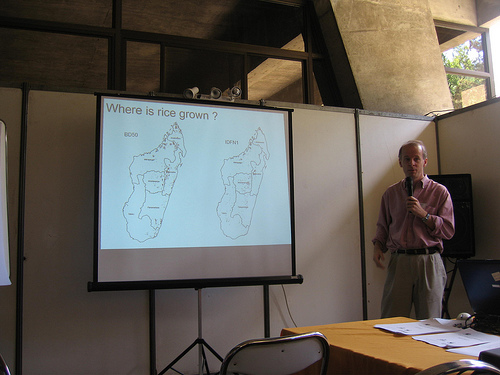Over at Ecosystem and Poverty, our friend and occasional guest contributor Andy is asking whether anyone has a use for bamboo flowering culms… BTW, thanks for linking to our latest posts, Andy.
Time for a little learning?
This should be interesting. (Although I cannot for the life of me see how to make a picture appear in the black box below. Trust me; click.)
According to the blurb, “Unlike old-fashioned DVDs, this interactive Digital Learning Tool (iDLT) puts you smack in the driver’s seat. From the moment you click “Get Started,†your hosts, outdoorsy Olivia and tech-savvy Seth, are ready to take you around the world to discover agricultural biodiversity”.
Alas, from the clip all I learned was how jolly clever Olivia and Seth and the DVD makers are. But the nice people at PhotoSynthesis Productions have said they’ll send us a copy so we’ll be able to report in more depth. In the meantime, have any of you seen it? What did you think?
An archaeodentist’s take on domestication
Jason at Hominim Dental Anthropology (a bit of a mouthful; hahahaha) has been taking a look at some recent papers on domestication. The papers are, by his own admission, nothing new. We’ve covered some of them ourselves here. What I thought was interesting was the stress on the timing and duration of domestication and Jason’s views of what constitutes “nature” and “natural”. He seems, to me, to be a bit confused as to whether Homo sapiens (just another unique species, as Rob Foley puts it) is a part of nature, or apart from nature and yet with its (our?) own nature.
Agrobiodiversity and climate change in Madagascar
There’s a workshop going on in Antananarivo on the Impacts of Climate Change on Madagascar’s Biodiversity and Livelihoods. My friend Robert Hijmans is there and he sent me the link to the flickr site of one of the participants, Ratoza Harinjaka, who’s got some photos of the meeting up. Including this one of Robert.

Ratoza has kindly given his permission for us to use the photo. He has blogged about the workshop. Thanks for the use of the pic, Ratoza. If either you or Robert would like to write something for us on the meeting, you’re most welcome to do so. It sounds like the recommendations will be on the Foko website in due course. But it’s always nice to get it from the horse’s mouth.
Potato salad
I don’t know if it’s because of the International Year of the Potato, but there’s been a fair amount on the spud in the news lately. I nibbled a few days ago news of a paper which will cause a major rethink on the worldwide spread of the potato. Virtually all modern potato varieties are derived from landraces from the lowlands of southern and central Chile. Why? Some people think it’s because those are the first ones that arrived in Europe. Others that there were also highland Andean varieties in Europe, but that they got wiped out by late blight. But analyzing DNA from old herbarium specimens shows that both types of potatoes were grown in Europe both before and after late blight hit. So a new theory is needed.
Then there was a short piece on the CIP collection in LatinAmericaPress. Note the cool picture of diversity in the colour of potato flesh. I’m not sure what prompted the article, but it may have been a CGIAR press release on how the international centres, including CIP, are sending germplasm for safety duplication in Svalbard in time for the opening in three weeks’ time.
CIP was also in the news with the announcement of the establishment of Red Latinpapa. That’s the Latin American Network for Innovation on Potato Improvement and Dissemination. Its “aim is to help poor potato farmers in Latin America improve their income and reduce costs by making it easier for them to access new technologies and varieties and getting their input into what traits are most useful.” Among other things, “Latinpapa will stimulate exchange and analysis of genetic material between researchers in the region.” A busy time ahead for the CIP genebank, and national genebanks around the region, I guess.
And finally, a bit of fun. Remember the picture of sliced potatoes in the LatinAmericaPress article showing lots of different colours and patterns? Of course, because of the relatively narrow base of modern potato varieties, as described in that USDA paper I started with, we don’t get potato chips (crisps for the Brits among us) in all these different colours. Bummer.
But maybe we will soon. Someone in Switzerland is indeed working on a blue chip. But in fact mixtures of blue and white chips are already commercially available in the US. Although they “have a weird flavor that is not quite potato.” Sounds intriguing…